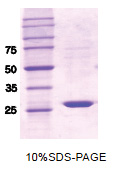PTPN6 (243-541) Human Protein
Other products for "PTPN6"
Specifications
| Product Data | |
| Species | Human |
| Expression Host | E. coli |
| Expression cDNA Clone or AA Sequence |
MGFWEEFESL QKQEVKNLHQ RLEGQRPENK GKNRYKNILP FDHSRVILQG RDSNIPGSDY INANYIKNQL LGPDENAKTY IASQGCLEAT VNDFWQMAWQ ENSRVIVMTT REVEKGRNKC VPYWPEVGMQ RAYGPYSVTN CGEHDTTEYK LRTLQVSPLD NGDLIREIWH YQYLSWPDHG VPSEPGGVLS FLDQINQRQE SLPHAGPIIV HCSAGIGRTG TIIVIDMLME NISTKGLDCD IDIQKTIQMV RAQRSGMVQT EAQYKFIYVA IAQFIETTKK KLEVLQSQKG QESEYGNITY
|
| Predicted MW | 34.381 kDa |
| Concentration | lot specific |
| Purity | >95% by SDS-PAGE |
| Buffer | Presentation State: Purified State: Liquid purified protein Buffer System: 25 mM Tris-HCl, pH7.5, 2 mM β-mercaptoethanol, 1 mM EDTA.1mMDTT, 20%Glycerol |
| Bioactivity | Specific: - One unit will hydrolyze 1 nanomole of p-nitrophenylphosphatate per minute at pH 7.5 at 37°C using 10mM of substrate |
| Preparation | Liquid purified protein |
| Protein Description | The protein coding region of the catalytic domain of SHP-1 (amino acids 243-541) was cloned into an E. coli expression vector. The catalytic domain of SHP-1 was overexpressed as insoluble protein aggregates (inclusion bodies). The recombinant SHP-1 protein was purified by FPLC gel-filtration chromatography, after refolding of the isolated inclusion bodies in a redox buffer. Additional amino acid(Met) is attached at N-terminus. |
| Storage | Store undiluted at 2-8°C for up to two weeks or (in aliquots) at -20°C or -70°C for longer. Avoid repeated freezing and thawing. |
| Stability | Shelf life: one year from despatch. |
| Reference Data | |
| RefSeq | NP_002822 |
| Locus ID | 5777 |
| UniProt ID | P29350 |
| Cytogenetics | 12p13.31 |
| Synonyms | HCP; HCPH; HPTP1C; PTP-1C; SH-PTP1; SHP-1; SHP-1L; SHP1 |
| Summary | 'The protein encoded by this gene is a member of the protein tyrosine phosphatase (PTP) family. PTPs are known to be signaling molecules that regulate a variety of cellular processes including cell growth, differentiation, mitotic cycle, and oncogenic transformation. N-terminal part of this PTP contains two tandem Src homolog (SH2) domains, which act as protein phospho-tyrosine binding domains, and mediate the interaction of this PTP with its substrates. This PTP is expressed primarily in hematopoietic cells, and functions as an important regulator of multiple signaling pathways in hematopoietic cells. This PTP has been shown to interact with, and dephosphorylate a wide spectrum of phospho-proteins involved in hematopoietic cell signaling. Multiple alternatively spliced variants of this gene, which encode distinct isoforms, have been reported. [provided by RefSeq, Jul 2008]' |
| Protein Families | Druggable Genome, Phosphatase, Stem cell - Pluripotency |
| Protein Pathways | Adherens junction, B cell receptor signaling pathway, Jak-STAT signaling pathway, Natural killer cell mediated cytotoxicity, T cell receptor signaling pathway |
Documents
| FAQs |
Resources
Recombinant Protein Resources |
{0} Product Review(s)
0 Product Review(s)
Submit review
Be the first one to submit a review
Product Citations
*Delivery time may vary from web posted schedule. Occasional delays may occur due to unforeseen
complexities in the preparation of your product. International customers may expect an additional 1-2 weeks
in shipping.






























































































































































































































































 Germany
Germany
 Japan
Japan
 United Kingdom
United Kingdom
 China
China
